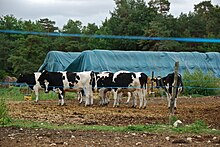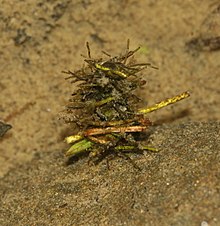Aquatic biomonitoring

Aquatic biomonitoring is the science of inferring the ecological condition of rivers, lakes, streams, and wetlands by examining the organisms (fish, invertebrates, insects, plants, and algae) that live there. While aquatic biomonitoring is the most common form of biomonitoring, any ecosystem can be studied in this manner.
Purpose[]


Aquatic biomonitoring is an important tool for assessing aquatic life forms and their ecosystems. Monitoring aquatic life can also be beneficial in understanding land ecosystems.[1][2]
Aquatic biomonitoring can reveal the overall health and status of the environment, can detect environmental trends and how different stressors will affect those trends, and can be used to evaluate the effects that various environmental activities may have on the overall health of the environment. Water pollution and general stresses to aquatic life have a major impact on the environment. The main sources of pollution to oceans, rivers, and lakes are human caused events or activities, such as sewage, oil spills, surface runoff, littering, ocean mining, and nuclear waste. Rapid changes to an environment, like, pollution, can alter ecosystems and community assemblages, and endanger species that live in or close to water. Many aquatic species also serve as food sources for terrestrial species. Thus, aquatic ecosystems are interconnected with their adjacent terrestrial ecosystem.
Indicator organisms[]


Aquatic invertebrates, most popularly the larva of the caddis fly sp., are responsive to climate change, low levels of pollution and temperature change.[3][4] As a result, they have the longest history of use in biomonitoring programs.[5] Additionally, macroscopic species: frogs, fish, and some plant species, as well as, many forms of microscopic life, like bacteria and protozoa are used as indicator organisms in a variety of applications, storm water run-off among them.[6] Many species of Macroalgae are used in biomonitoring for both aquatic and marine environments.[7]
Common methods[]
A biomonitoring assessment typically requires two or more sets of data . First, a baseline dataset that, ideally, defines the environment in its natural state, or default state.[8] This is used to compare with any datasets that follow.
Methods employed in aquatic biomonitoring[]
- monitoring and assessing aquatic species (incl. plants, animals, and bacteria)
- monitoring the behavior of certain aquatic species and assessing any changes in species behavior
- analyzing the biochemical make-up of the waterbody, and its potential influence on the species that depend on it.[9]
Common tools of ecological and biological assessments[]
- Bioassays. Test organisms are exposed to an environment and their response is measured. Typical organisms used in bioassays are certain species of plants, bacteria, fish, water fleas (Daphnia), and frogs.
- Community assessments. Also called biosurveys. An entire community of organisms is sampled to see what types of taxa remain. In aquatic ecosystems, these assessments often focus on invertebrates, algae, macrophytes (aquatic plants), fish, or amphibians.[10][11] Rarely, other large vertebrates (reptiles, birds, and mammals) may be considered.
- Online biomonitoring devices. One example uses chemoreceptor cells of mollusks and similar animals to monitor their coastal and fresh water habitats. Different types of animals are used for this purpose either in the lab or in the field. The study of the opening and closing activity of clams' valves is an example of one possible way to monitor in-situ the quality of fresh and coastal waters.[12]
Variables considered[]
Water quality[]
Water quality is graded both on appearance—for example: clear, cloudy, full of algae—and chemistry.[13] Determining the specific levels of enzymes, bacteria, metals, and minerals found in water is extremely important. Some contaminants, such as metals and certain organic wastes, can be lethal to individual creatures and could thereby ultimately lead to extinction of certain species.[9] This could affect both aquatic and land ecosystems and cause disruption in other biomes and ecosystems.
Water temperature[]
Water body temperature is one of the most ubiquitous variables collected in aquatic biomonitoring. Temperatures at the water surface, in the water column, and at the water bodies bottom can all provide insight into different aspects of an aquatic ecosystem. Water temperature is directly effected by climate change and can have negative affects on many aquatic species, such as salmon.[14][15]
Community make-up[]
Species community assemblages and changes there in can help researchers to infer changes in the health of an ecosystem. In typical unpolluted temperate streams of Europe and North America, certain insect taxa predominate. Mayflies (Ephemeroptera), caddisflies (Trichoptera), and stoneflies (Plecoptera) are the most common insects in these undisturbed streams. In contrast, in rivers disturbed by urbanization, agriculture, forestry, and other perturbations, flies (Diptera), and especially midges (family Chironomidae) predominate.
Local geology[]
Local geology can effect sub-surface influences on surface water, for example, metal contamination.[16]
See also[]
- Ecology portal
- Bioindicator
- Biological integrity
- Biological monitoring working party (a measurement procedure)
- Indicator species
- Water pollution
References[]
- ^ Vandewalle1 de Belo2 Berg3, M.1 F.2 M.P.3 (September 2010). "Functional traits as indicators of biodiversity response to land use changes across ecosystems and Organisms". Biodivers Conserv.
- ^ "Why Biological Monitoring?". Monitoring and Assessment. Augusta, ME: Maine Department of Environmental Protection. Retrieved 2020-03-27.
- ^ Lawrence1, Lunde2, Mazor3, Bêche4, McElravy5, Resh6, J.E.1, K.B.2, R.D.3, L.A.4, E.P.5, V.H.6. "Long-Term Macroinvertebrate Responses to Climate Change: Implications for Biological Assessment in Mediterranean-Climate Streams". Journal of the North American Benthological Society.CS1 maint: multiple names: authors list (link)
- ^ "Vulnerability of stream biota to climate change in mediterraneanclimates: a synthesis of ecological responses and conservation challenges". Hydrobiologia. doi:10.1007/s10750-012-1244-4. hdl:2445/48186. S2CID 17658477.
- ^ Barbour1 Gerritsen2 Snyder3 Stribling4, M.T.1 J.2 B.D3 J.B4 (1999). "Rapid Bioassessment Protocols for Use in Streams and Wadeable Rivers: Periphyton, Benthic Macroinvertebrates and Fish". U.S. Environmental Protection Agency (EPA); Office of Water.
- ^ Jeng1 England2 Bradford3, Hueiwang C.1 Andrew J.2 Henry B.3 (2005). "Indicator Organisms Associated with Stormwater Suspended Particles and Estuarine Sediment". Journal of Environmental Science and Health. 40 (4): 779–791. doi:10.1081/ESE-200048264. PMID 15792299 – via https://www.tandfonline.com/action/journalInformation?journalCode=lesa20.
- ^ Phillips, David J.H. "THE USE OF BIOLOGICAL INDICATOR ORGANISMS TO MONITOR TRACE METAL POLLUTION IN MARINE AND ESTUARINE ENVIRONMENTS--A REVIEW". University of Zoology, Uppsala, Sweden – via Elsevier.
- ^ Burrows, Justin M.; Clawson, Chelsea M. (September 2020). Baseline Aquatic Biomonitoring for the Anarraaq and Aktigiruq Prospects near the Red Dog Mine, 2019 (PDF) (Report). Fairbanks, AK: Alaska Department of Fish and Game. Technical Report No. 20-06.
- ^ Jump up to: a b Bartram, Jamie; Ballance, Richard, eds. (1996). Water Quality Monitoring: A Practical Guide to the Design and Implementation of Freshwater Quality Studies and Monitoring Programmes. CRC Press. ISBN 978-0419217305.
- ^ Karr, James R. (1981). "Assessment of Biotic Integrity Using Fish Communities". Fisheries. American Fisheries Society. 6 (6): 21–27. doi:10.1577/1548-8446(1981)006<0021:AOBIUF>2.0.CO;2.
- ^ Burger, Joanna; Snodgrass, Joel (June 2001). "Metal Levels in Southern Leopard Frogs from the Savannah River Site: Location and Body Compartment Effects". Environmental Research. Elsevier. 86 (2): 157–166. doi:10.1006/enrs.2001.4245.
- ^ "MolluScan Eye". Environnements et Paléoenvironnements Océaniques et Continentaux.
- ^ "Biomonitoring". Water Quality Monitoring & Assessment. Troy, NY: New York State Department of Environmental Conservation. Retrieved 2021-03-16.
- ^ Van Vliet, Michelle T.H.; Wietse, H.P. Franssen; Yearsley, John R.; Ludwig, Fulco; Haddeland, Ingjerd; Letenmaier, Dennis P.; Kabat, Pavel (April 2013). "Global river discharge and water temperature under climate change". Global Climate Change. Elsevier. 23 (2). doi:10.1016/j.gloenvcha.2012.11.002.
- ^ Jonsson, B.; Jonsson, N. (January 2010). "A review of the likely effects of climate change on anadromous Atlantic salmon Salmo salar and brown trout Salmo trutta, with particular reference to water temperature and flow". Journal of Fish Biology. The Fisheries Society of the British Isles. 75 (10). doi:10.1111/j.1095-8649.2009.02380.x.
- ^ Rowles III, Lewis Stetson; Hossain, Areeb I.; Aggarwal, Srijan; Kirisits, Mary Jo; Saleh, Navid B. (April 2020). "Water quality and associated microbial ecology in selected Alaska Native communities: Challenges in off-the-grid water supplies". Science of the Total Environment. Elsevier. 711: 134450. doi:10.1016/j.scitotenv.2019.134450.
External links[]
- Aquatic ecology
- Bioindicators
- Environmental science
- Measurement of biodiversity
- Water pollution

